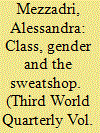| Srl | Item |
| 1 |
ID:
148274


|
|
|
|
|
| Summary/Abstract |
Drawing on approaches to class emphasising the multiplicity of labour relations at work under capitalism, and from feminist insights on oppression and social reproduction, this paper illustrates the interconnection between processes of class formation and patriarchal norms in globalised production circuits. The analysis emphasises the nexus between the commodification and exploitation of women’s labour, and how it structures gendered wage differentials, labour control and the high ‘disposability’ of women’s work. The analysis develops these arguments by exploring the case of the Indian garment industry and its gendered sweatshop regime. It illustrates how commodification and exploitation interplay in factory and home-based realms, and discusses how an approach on class premised on social reproduction changes the social perimeters of what we understand as labour ‘unfreedom’ and labour struggles.
|
|
|
|
|
|
|
|
|
|
|
|
|
|
|
|
| 2 |
ID:
087997


|
|
|
|
|
| Publication |
2009.
|
| Summary/Abstract |
This paper presents an active learning module design and implementation strategy for use in an undergraduate course on globalization, world politics, international political economy, or international relations. Students are first asked to conduct research on their wardrobe and its origins by country, allowing for classroom discussion of research methods and designs. Results are submitted, along with a short response essay. This is evaluated in conjunction with a case-study short reading and shared discussion, followed by a short video/multimedia presentation on free trade and labor issues. Drawing on literature on active learning, I argue that this presents a more cohesive approach for engaging students in the material on a substantive level, while at the same time allowing them to actively appreciate and understand such diverse concepts as commodity chains, free trade zones, fair trade versus free trade, gendered divisions of labor, consumer responsibility, research methodologies, and macroeconomic shifts in employment across nations. This also serves as a rubric for instructors to use in creating their own topical "modules." Preliminary data and classroom results are discussed, as are additional strategies for lesson development.
|
|
|
|
|
|
|
|
|
|
|
|
|
|
|
|